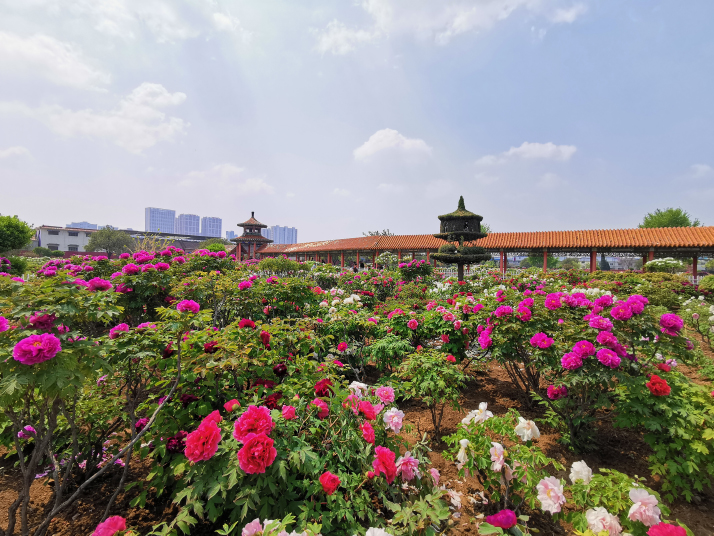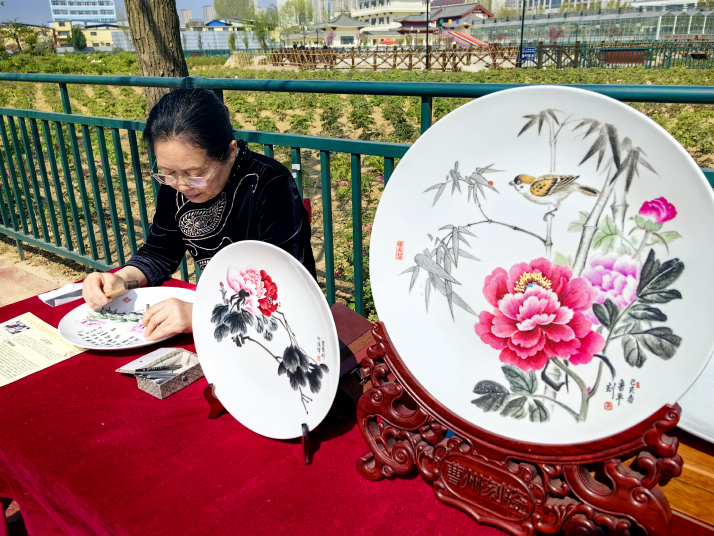
A cluster of tall buildings rising straight out of the wheat fields, at first glance, Heze differs little from any of the other small cities on the North China Plain. However, the city is gaining increasing recognition in China and internationally for its use of its traditional heritage as a resource for building prosperity.
Located in southwest Shandong Province, around 600 km south of Beijing, Heze has centuries of history as a center for peony cultivation and is still a global powerhouse in the breeding and production of this much sought-after flower. Over recent years, the city's government, businesses and community have thrown their full force behind the diversification of the peony industry, using both scientific and cultural innovation to develop new products, create new demand and raise the fortunes of the city and its people.
Building on these successes, Heze is now looking beyond China's shores to share its peony culture internationally. In doing so, the city hopes not only to continue the expansion of its signature industry but also to contribute its famous peonies as a bridge for China's ongoing efforts in global community building and exchange.

The King of Flowers
Heze is China's hotly disputed capital of peonies, with Luoyang in neighboring Henan Province also pressing its claim on the title. Both cities can boast centuries of peony-producing history, but it is Luoyang that holds the claim as the original home of China's favorite flower.
Peonies have been used in traditional medicine throughout China for thousands of years, but those first cultivated as ornamental flowers in Luoyang rose to feverish levels of fame during the Tang Dynasty (618-907). Cultivated extensively in the Tang capitals of Luoyang in the east and Changan, now Xi'an in Shaanxi Province, in the west, the short period of their blooming drew such enormous crowds that Tang poet Liu Yuxi (772-842) described the season of their opening as "rocking the entire capital." Similarly, a poem by Liu's contemporary Bai Juyi read that in the 20 days from the flowers opening to them dropping, the entire city went mad.
So closely tied were peonies to the imperial family and nobility, that their centers of production changed with the changing of China's dynasties until Heze emerged as the final peony capital in the Ming Dynasty (1368-1644). Over the past 400 years, Heze has come to surpass all other cities in its production of peonies, being home to 1,280 cultivars—divided into nine colors and 10 shapes. Today, Heze continues to follow the centuries-old tradition of supplying the capital with peonies, with 80-90 percent of those grown in Beijing originating in Heze.
This long history of infatuation with peonies has imbued in them centuries of cultural meaning and inherent symbolism. Their long association with the nobility has conveyed a well-deserved nobility upon them, their supreme beauty has led to their use as a symbol of beauty and their cultivation over generations from wild stock is an achievement in the harmony between humans and nature. In these ways, and many others, peonies have come to symbolize the pinnacle of many traditional Chinese ideals, and their importance within literature and culture, combined with the nation's love for them, has led to them becoming known by a second name, the King of Flowers.
Peonies for prosperity
Common prosperity has been a nationwide pursuit over the course of China's modern development. Having roots in traditional Chinese philosophy, the concept calls for increased economic and social equality, the promotion of a large middle class and the reduction of divides such as the rural-urban development gap. The central authorities have been empowering local governments to take charge of their own paths to common prosperity, making use of their distinctive local resources and advantages to create opportunities for balanced, people-centric growth. While, in terms of volume, Heze's grain production far outweighs its production of peonies, the distinctive nature of the city's relationship with the flowers and the position they hold within the nation's culture have made them a natural choice as a vehicle for innovation in the pursuit of prosperity.
Now, local peony art hangs above locally produced peony-patterned carpets and tiles in the halls of Heze's buildings. Peony-patterned bottled water stands in shops alongside peony-petal and peony-stamen teas, peony-shaped and peony-flavored ice creams, and peony cakes. Peony-themed amusement parks offer peony-themed souvenirs to peony-loving tourists. Also, peony-themed hotels serve peony-themed banquets on peony-patterned porcelain, washed down with peony-flavored baijiu, or Chinese distilled spirits.
Research has found that the consumption of peony-seed oil has cardiovascular and other health benefits, leading to developments such as the production of cooking oils and health foods, as well as the application of peonies in the production of skincare products, cosmetics and even toothpaste.
Heze has grasped its distinctive local advantage with both hands and now has more than 120 companies operating within peony-related industries, producing an annual output valued at 10 billion yuan ($1.45 billion) and creating a demand for 25,000 tons of peonies each year. This demand is creating increased economic opportunities for peony growers and new forms of employment for Heze's residents.
Going global
The short time the peonies are in bloom makes mid-spring a busy time in Heze, and early April has seen the city launch the 32nd Heze International Peony Cultural Tourism Festival on April 7, host the 2023 World Peony Conference on April 8-10 and inaugurate the Heze Peony International Communication Forum on April 9. Held to find new ways to share peony-related culture internationally, the forum welcomed the next phase in the city's ongoing cultural and economic development. Internationalizing peony culture and encouraging the appreciation of China's unofficial national flower will not only create new opportunities for Heze's products but also contribute to China's efforts in international cultural engagement and exchange.
Lu Cairong, Vice President of China International Communications Group, told the forum via video link that peonies have been a vivid example of cultural exchange and integration between China and other countries for centuries, but that as times change and new technologies develop, it is necessary to innovate the methods of international communication surrounding the flower to spur on industrial development and further cultural exchange. Lu said peony-related
international communication should not only be diverse but also localized and should go hand in hand with the building of well-known peony-related intellectual property and culture.
Speaking on the power of peonies for cultural engagement overseas, Xi Yanchun, Director of the Information Office of the provincial government, told the forum that work must be done to share the story of Heze's peony-related development with international audiences and create a culture of mutual learning around peonies.
Heze's innovative use of peonies for economic and cultural development has become a prominent national example of the pursuit of common prosperity. Through innovations in international communication, this example can also be of value to overseas communities pursuing development and prosperity. By sowing the (peony) seeds of cultural sharing, people can reap the increased understanding that is currently so needed among nations.
(Reporting from Heze, Shandong Province)
Copyedited by Elsbeth van Paridon
Comments to yanwei@cicgamericas.com